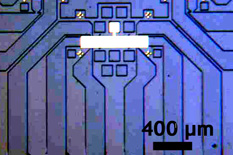Assistant Professor John Cumings
 Materials Science and Engineering Associate Professor John Cumings, in collaboration with colleagues at Stanford University, Penn State University, and the National High Magnetic Field Laboratory (Los Alamos, New Mexico), has published groundbreaking research on the discovery of a previously unknown magnetic property of a nonferromagnetic alloy of zinc, cadmium, manganese, and selenium. The paper, titled "Tunable Anomalous Hall Effect in a Nonferromagnetic System," appears in Physical Review Letters 96, 196404 (2006). Cumings and his colleagues also presented the paper at Harvard University, Michigan State University, Rice University, Hitachi (Almaden facility, San Jose) and the Kavli Institute (Santa Barbara) during the spring semester of 2006.
Materials Science and Engineering Associate Professor John Cumings, in collaboration with colleagues at Stanford University, Penn State University, and the National High Magnetic Field Laboratory (Los Alamos, New Mexico), has published groundbreaking research on the discovery of a previously unknown magnetic property of a nonferromagnetic alloy of zinc, cadmium, manganese, and selenium. The paper, titled "Tunable Anomalous Hall Effect in a Nonferromagnetic System," appears in Physical Review Letters 96, 196404 (2006). Cumings and his colleagues also presented the paper at Harvard University, Michigan State University, Rice University, Hitachi (Almaden facility, San Jose) and the Kavli Institute (Santa Barbara) during the spring semester of 2006.
Unlike ferromagnitic materials whose spin (magnetic strength) is predetermined by their chemical makeup, the properties of paramagnetic semiconductors like the alloy in Cumings’ study can be tuned by varying carrier density, magnetic field, or temperature. The ability to control the spin of and electron transport through a material makes it flexible; it can be used in multiple applications and devices, and its magnetic properties can be altered or turned on and off as needed. Devices created with such materials, called spintronics, could prove to be more efficient and diversified than traditional electronics.
Cumings and his colleagues measured the low-field Hall resistivity of a magnetically doped two-dimensional electron gas as a function of temperature and electrically gated carrier density. Comparing these results with the carrier density extracted from Shubnikov–de Haas oscillations revealed an excess Hall resistivity that increased with decreasing temperature. This excess Hall resistivity qualitatively tracked the paramagnetic polarization of the sample, in analogy to the ferromagnetic anomalous Hall effect. The data were consistent with skew scattering of carriers by disorder near the crossover to localization. (View the article online at Physical Review Letters »)
Cumings was invited to present his findings at the Meeting of the American Physical Society, March 5-9, 2007 in Denver, Colorado. The annual "March Meeting" focuses on condensed matter and materials physics, and is considered a showcase for the best in physics research.
Top